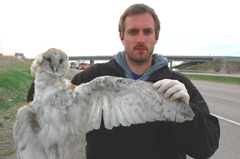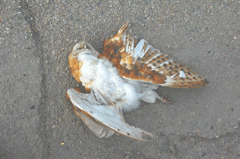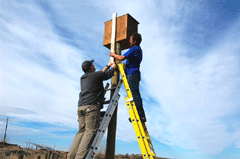Raptor Ruin
Air Date: Week of August 10, 2007

(Photo: Guy Hand)
It's an intercontinental phenomenon that has researchers stumped. Barn owls are getting killed by the thousands on the highways. Barn owl roadkill greatly outnumbers that of other raptors, and other animals, and it's happening from Idaho to Britain. Producer Guy Hand reports.
Transcript
CURWOOD: It usually happens on a lonely highway late at night. Suddenly something ghostly-white flashes through headlights. That apparition could very likely have been a barn owl. And odds are it didn’t survive the encounter. Indeed, large numbers of barn owls are meeting their fate on the highways. Producer Guy Hand joins researchers as they take to the road searching for clues to these mysterious deaths.
[HIGHWAY AND TRAFFIC NOISE]
BOVES: So immediately when we look at this bird you can tell it's got a broken wing, possibly a broken neck. So it probably got clipped by a semi, got knocked to the side of the road and then died.
HAND: Than Boves, graduate student at nearby Boise State University, has gotten really good at spotting dead barn owls. After all, he's spent two years prowling a 100 mile stretch of Interstate 84 through the southern Idaho desert—often driving 20 miles below the speed limit—scanning the shoulder for road kill.

Owl on the side of the road.(Photo: Guy Hand)
HAND: He tosses the flat disk of feathers, frisbee-like, into the dry grass. It's too far gone for study.
BOVES: We've seen four barn owls now.
HAND: That's four in close to a half hour. I ask him how many he's seen in a day.
BOVES: I guess my record is104 barn owls in one day. The last 30 miles were done in the dark and by the end my eyes were sore, my head was hurting and I probably wasn't as good at detecting barn owls by the end of the day as I was at the beginning. So I would guess there were 150 or more barn owls in one single day.
HAND: The deaths are more striking if you look at the researcher's entire study period.
BOVES: We came up with a range of between 1400 and about 3,000 birds over two years.
HAND: Boves has found all kinds of dead animals—even a peacock—on this 100-mile stretch of treeless highway. But wild or domestic, barn owls out number them all.
BOVES: We've found three or four times more dead barn owls than squirrels, than skunks, than raccoons, than cats than dogs. They are the most commonly-killed animal along the highway. So I think that's just unbelievable and the fact that I've only seen two or three live ones ever in my life, and now I'm finding thousands and thousands of dead ones.

Than Boves and dead barn owl.(Photo: Guy Hand)
BELTHOFF: “Are you guys aware that there are lots of barn owls being killed?” He and his family counted something like 80 as he traveled along Interstate 84. And they said “I'm sure you're aware of this and you're probably studying it and thanks for you efforts.” But in fact we didn't have a study going on and we weren't aware of it at that point in time.
HAND: This early in the research, Belthoff can only guess at why these elusive, nocturnal hunters are the area's number one road kill.
BELTHOFF: There's something about barn owls that make them unique in this regard or much more likely to be hit by the traffic. And it doesn't matter whether it's an interstate highway or a two-lane road where the speed limit might be 55 miles an hour.
HAND: It's likely that barn owls are being attracted to an abundance of rodents on or near the highway.
BELTHOFF: But there are lots raptors being attracted to these areas and we're not finding them dead in anywhere near the numbers we're finding barn owls.
HAND: Of all the dead raptors—hawks, falcons, and owls—90 percent were barn owls. But why? There are plenty of possibilities: that changes in headlight technology or the sounds of traffic confuse the owls, that vortices whipped up by 18-wheelers suck them under, or that pesticides slow their responses.
[HIGHWAY SOUNDS]
HAND: Back on the highway, Than Boves finds another dead barn owl and one more clue that suggests agriculture may play a part.
BOVES: I've noticed that a lot of times where grain has been spilt along the roadway we'll find three, four, five dead barn owls. So that grain may be attracting rodents in, which then attracts the barn owls which then causes them to die.
HAND: Even after all this time and dead owls, Boves winces a little as he picks up yet another rumpled mound of feathers. Surprisingly, barn owls aren't just dying this way in North America. In fact, David Ramsden of the Barn Owl Trust in England has been studying the same phenomenon there for 15 years.
RAMSDEN: Our evidence suggested that about three quarters, 72 percent of the birds that are known to encounter a major road were killed during the encounter. We've got studies coming out of Holland and France and Switzerland showing really, really high levels.
HAND: Some have theorized that it must be inexperienced or unfit birds that are most often getting killed, but British studies suggest just the opposite.
RAMSDEN: The major roads are not knocking out birds that were going to die anyway, they are knocking out the birds which are the survivors.
HAND: When a young barn owl starts to fly in those early days, it's immediately exposed to a lot of dangers. It could fly into overhead wires, it could drown in a cattle trough, it could starve to death, it could be hit on a minor road. And the birds that actually survive those early dangers are the ones that encounter the major roads, because they've survived and they've dispersed that bit further.
HAND: So many of these survivors die on major
British roadways that localized barn owl extinctions occur in as little as three years after a highway is built. But David Ramsden does have solutions: one with the message, fly high.
RAMSDEN: So our primary recommendation to the government here in England is that when they're designing a major road, instead of having the lowest vegetation by the carriage way and any trees or shrubs set further back, we're suggesting that they reverse that and they put the trees and shrubs right next to the carriage way. So basically we're looking for kind of linear screens along the roads, forcing birds that cross the roads to fly higher.
[SOUND OF MOVING LADDER]
BOVES: This is a nice spot. So you want to set up the box so the hole is kind of facing the northeast.

Putting up Owl Box (Photo: Guy Hand)
BOVES: I've spent so much time with dead ones that I'm actually really looking forward to once we get these barn owl boxes up to coming back and getting to work with some of the live ones. And that's another thing I'm kind of pleased with also, the fact that my research has at least lead to this project where we're now providing a next step.
[HIGHWAY SOUNDS]
HAND: Writer Barry Lopez, in his essay "Apologia," laments the death of animals on our highways. He writes of driving through the valleys of Idaho as evening rises and nighthawks start swooping the road for gnats "silent on the wing as owls."
[SOUND OF CRICKETS]
He says "We Treat the attrition of lives on the road like the attrition of lives in war: horrifying, unavoidable, justified." And he asks "What has gone under or past while I stared at mountains, hay meadows, fencerows, the beryl surface of rivers?"
The answer, we now know, must often be "barn owl." For Living On Earth, I'm Guy Hand in southern Idaho.
[MUSIC: David Hyams with the Miles to Go Band “Flight of the Sea Slug/East of Cape Arid”from ‘Knowing the Place’ (David Hyams – 2005)]
Links
Living on Earth wants to hear from you!
Living on Earth
62 Calef Highway, Suite 212
Lee, NH 03861
Telephone: 617-287-4121
E-mail: comments@loe.org
Newsletter [Click here]
Donate to Living on Earth!
Living on Earth is an independent media program and relies entirely on contributions from listeners and institutions supporting public service. Please donate now to preserve an independent environmental voice.
NewsletterLiving on Earth offers a weekly delivery of the show's rundown to your mailbox. Sign up for our newsletter today!
 Sailors For The Sea: Be the change you want to sea.
Sailors For The Sea: Be the change you want to sea.
 The Grantham Foundation for the Protection of the Environment: Committed to protecting and improving the health of the global environment.
The Grantham Foundation for the Protection of the Environment: Committed to protecting and improving the health of the global environment.
 Contribute to Living on Earth and receive, as our gift to you, an archival print of one of Mark Seth Lender's extraordinary wildlife photographs. Follow the link to see Mark's current collection of photographs.
Contribute to Living on Earth and receive, as our gift to you, an archival print of one of Mark Seth Lender's extraordinary wildlife photographs. Follow the link to see Mark's current collection of photographs.
 Buy a signed copy of Mark Seth Lender's book Smeagull the Seagull & support Living on Earth
Buy a signed copy of Mark Seth Lender's book Smeagull the Seagull & support Living on Earth

